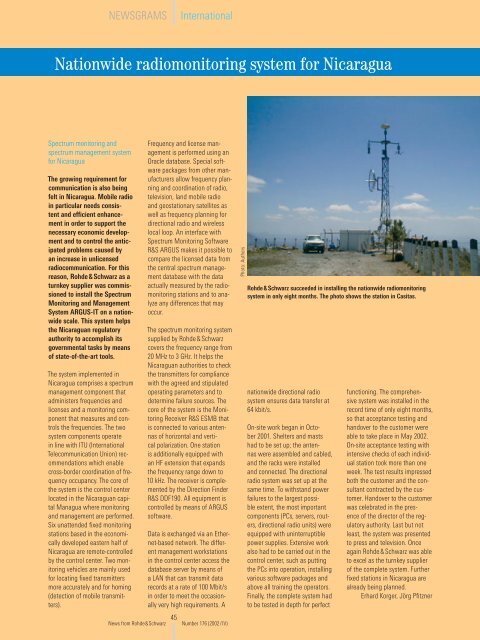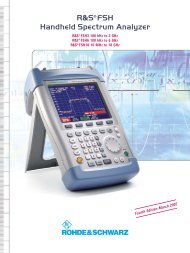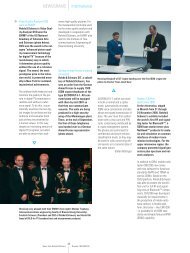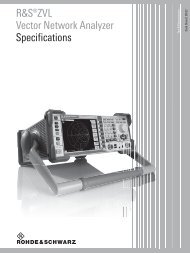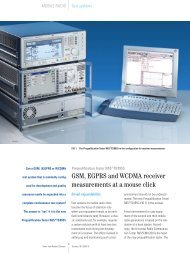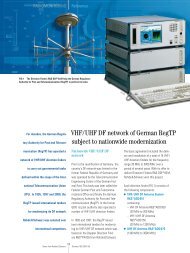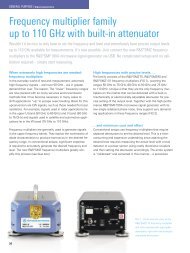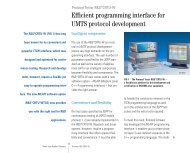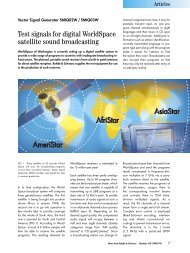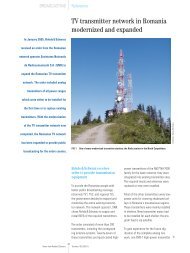English - Rohde & Schwarz
English - Rohde & Schwarz
English - Rohde & Schwarz
You also want an ePaper? Increase the reach of your titles
YUMPU automatically turns print PDFs into web optimized ePapers that Google loves.
NEWSGRAMS<br />
International<br />
Nationwide radiomonitoring system for Nicaragua<br />
Spectrum monitoring and<br />
spectrum management system<br />
for Nicaragua<br />
The growing requirement for<br />
communication is also being<br />
felt in Nicaragua. Mobile radio<br />
in particular needs consistent<br />
and efficient enhancement<br />
in order to support the<br />
necessary economic development<br />
and to control the anticipated<br />
problems caused by<br />
an increase in unlicensed<br />
radiocommunication. For this<br />
reason, <strong>Rohde</strong> & <strong>Schwarz</strong> as a<br />
turnkey supplier was commissioned<br />
to install the Spectrum<br />
Monitoring and Management<br />
System ARGUS-IT on a nationwide<br />
scale. This system helps<br />
the Nicaraguan regulatory<br />
authority to accomplish its<br />
governmental tasks by means<br />
of state-of-the-art tools.<br />
The system implemented in<br />
Nicaragua comprises a spectrum<br />
management component that<br />
administers frequencies and<br />
licenses and a monitoring component<br />
that measures and controls<br />
the frequencies. The two<br />
system components operate<br />
in line with ITU (International<br />
Telecommunication Union) recommendations<br />
which enable<br />
cross-border coordination of frequency<br />
occupancy. The core of<br />
the system is the control center<br />
located in the Nicaraguan capital<br />
Managua where monitoring<br />
and management are performed.<br />
Six unattended fixed monitoring<br />
stations based in the economically<br />
developed eastern half of<br />
Nicaragua are remote-controlled<br />
by the control center. Two monitoring<br />
vehicles are mainly used<br />
for locating fixed transmitters<br />
more accurately and for homing<br />
(detection of mobile transmitters).<br />
News from <strong>Rohde</strong>&<strong>Schwarz</strong><br />
Frequency and license management<br />
is performed using an<br />
Oracle database. Special software<br />
packages from other manufacturers<br />
allow frequency planning<br />
and coordination of radio,<br />
television, land mobile radio<br />
and geostationary satellites as<br />
well as frequency planning for<br />
directional radio and wireless<br />
local loop. An interface with<br />
Spectrum Monitoring Software<br />
R&S ARGUS makes it possible to<br />
compare the licensed data from<br />
the central spectrum management<br />
database with the data<br />
actually measured by the radiomonitoring<br />
stations and to analyze<br />
any differences that may<br />
occur.<br />
The spectrum monitoring system<br />
supplied by <strong>Rohde</strong> & <strong>Schwarz</strong><br />
covers the frequency range from<br />
20 MHz to 3 GHz. It helps the<br />
Nicaraguan authorities to check<br />
the transmitters for compliance<br />
with the agreed and stipulated<br />
operating parameters and to<br />
determine failure sources. The<br />
core of the system is the Monitoring<br />
Receiver R&S ESMB that<br />
is connected to various antennas<br />
of horizontal and vertical<br />
polarization. One station<br />
is additionally equipped with<br />
an HF extension that expands<br />
the frequency range down to<br />
10 kHz. The receiver is complemented<br />
by the Direction Finder<br />
R&S DDF190. All equipment is<br />
controlled by means of ARGUS<br />
software.<br />
Data is exchanged via an Ethernet-based<br />
network. The different<br />
management workstations<br />
in the control center access the<br />
database server by means of<br />
a LAN that can transmit data<br />
records at a rate of 100 Mbit/s<br />
in order to meet the occasionally<br />
very high requirements. A<br />
45<br />
Number 176 (2002/IV)<br />
Photo: Authors<br />
<strong>Rohde</strong> & <strong>Schwarz</strong> succeeded in installing the nationwide radiomonitoring<br />
system in only eight months. The photo shows the station in Casitas.<br />
nationwide directional radio<br />
system ensures data transfer at<br />
64 kbit/s.<br />
On-site work began in October<br />
2001. Shelters and masts<br />
had to be set up; the antennas<br />
were assembled and cabled,<br />
and the racks were installed<br />
and connected. The directional<br />
radio system was set up at the<br />
same time. To withstand power<br />
failures to the largest possible<br />
extent, the most important<br />
components (PCs, servers, routers,<br />
directional radio units) were<br />
equipped with uninterruptible<br />
power supplies. Extensive work<br />
also had to be carried out in the<br />
control center, such as putting<br />
the PCs into operation, installing<br />
various software packages and<br />
above all training the operators.<br />
Finally, the complete system had<br />
to be tested in depth for perfect<br />
functioning. The comprehensive<br />
system was installed in the<br />
record time of only eight months,<br />
so that acceptance testing and<br />
handover to the customer were<br />
able to take place in May 2002.<br />
On-site acceptance testing with<br />
intensive checks of each individual<br />
station took more than one<br />
week. The test results impressed<br />
both the customer and the consultant<br />
contracted by the customer.<br />
Handover to the customer<br />
was celebrated in the presence<br />
of the director of the regulatory<br />
authority. Last but not<br />
least, the system was presented<br />
to press and television. Once<br />
again <strong>Rohde</strong> & <strong>Schwarz</strong> was able<br />
to excel as the turnkey supplier<br />
of the complete system. Further<br />
fixed stations in Nicaragua are<br />
already being planned.<br />
Erhard Korger, Jörg Pfitzner


